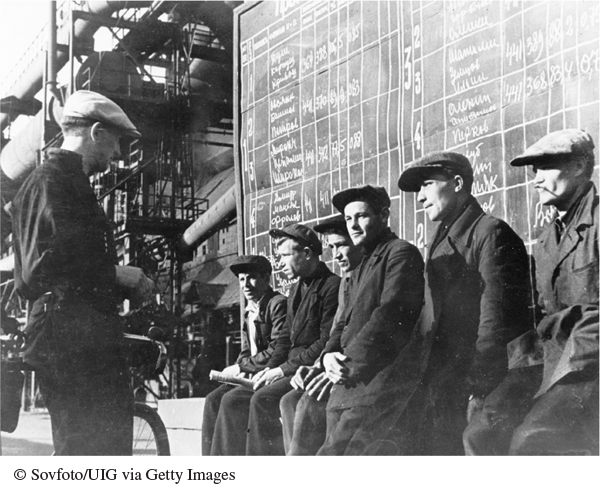Life and Culture in Soviet Society
Daily life was difficult in Stalin’s Soviet Union. The lack of housing was a particularly serious problem. Millions were moving into the cities, but the government built few new apartments. A relatively lucky family received one room for all its members and shared both a kitchen and a toilet with others living on the same floor.
There were constant shortages of goods as well. Because consumption was reduced to pay for investment, there was little improvement in the average standard of living in the years before World War II. The average nonfarm wage purchased only about half as many goods in 1932 as it had in 1928. After 1932 real wages rose slowly, but by 1937 workers could still buy only about 60 percent of what they had bought in 1928 and less than they could purchase in 1913. Collectivized peasants experienced greater hardships.
Life was by no means hopeless, however. Idealism and ideology had real appeal for many Communists and ordinary citizens, who saw themselves heroically building the world’s first socialist society while capitalism crumbled in a worldwide depression and degenerated into fascism in the West. This optimistic belief in the future of the Soviet Union attracted many disillusioned Westerners to communism in the 1930s. On a more practical level, Soviet workers received important social benefits, such as old-
Communism also opened possibilities for personal advancement. Rapid industrialization required massive numbers of skilled workers, engineers, and plant managers. In the 1930s the Stalinist state broke with the egalitarian policies of the 1920s and offered tremendous incentives to those who could serve its needs. It paid the mass of unskilled workers and collective farmers very low wages, but provided high salaries and special privileges to its growing technical and managerial elite. This group joined with the political and artistic elites in a new upper class, whose members grew rich and powerful.

The radical transformation of Soviet society had a profound impact on women’s lives. Marxists had traditionally believed that both capitalism and middle-
At the same time, women saw lasting changes in education. The Soviets opened higher education to women, who could now enter the ranks of the better-
Alongside such advances, however, Soviet society demanded great sacrifices from women. The vast majority of women had to work outside the home. Wages were so low that it was almost impossible for a family or couple to live only on the husband’s earnings. Peasant women continued to work on farms, and millions of women toiled in factories and in heavy construction, building dams, roads, and steel mills in summer heat and winter frost. Men continued to dominate the very best jobs. Finally, rapid change and economic hardship led to many broken families, creating further physical and emotional strains for women. In any event, the massive mobilization of women was a striking characteristic of the Soviet state.
Culture was thoroughly politicized for propaganda and indoctrination purposes. Party activists lectured workers in factories and peasants on collective farms, while newspapers, films, and radio broadcasts endlessly revealed capitalist plots and recounted socialist achievements. Whereas the 1920s had seen considerable modernist experimentation in art and theater, in the 1930s intellectuals were ordered by Stalin to become “engineers of human minds.” Following the dictates of “Socialist Realism,” they were instructed to exalt the lives of ordinary workers and glorify Russian nationalism. Russian history was rewritten so that early tsars such as Ivan the Terrible and Peter the Great became worthy forerunners of the greatest Russian leader of all — Stalin. Writers and artists who could effectively combine genuine creativity and political propaganda became the darlings of the regime.
914
Stalin seldom appeared in public, but his presence was everywhere — in portraits, statues, books, and quotations from his writings. Although the government persecuted those who practiced religion and turned churches into “museums of atheism,” the state had both an earthly religion and a high priest — Marxism-